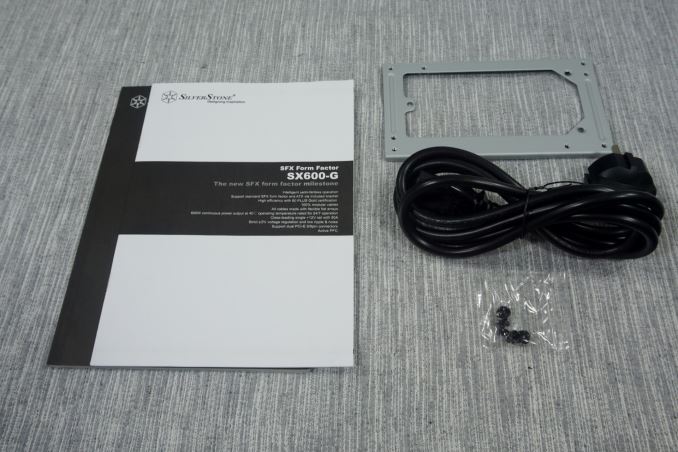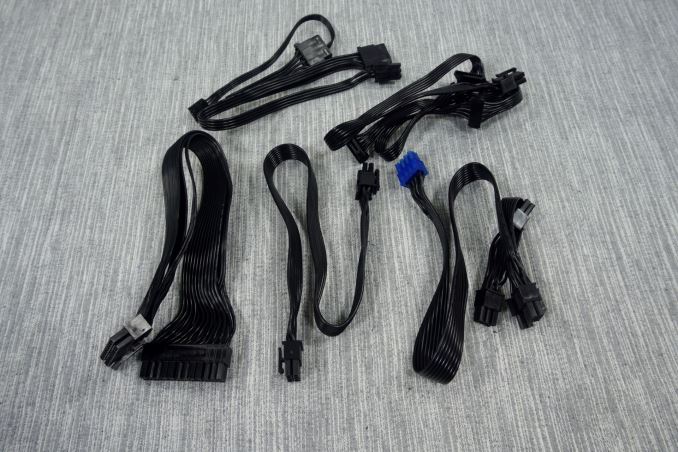The SilverStone SX600-G SFX PSU Review
by E. Fylladitakis on August 21, 2015 8:00 AM EST- Posted in
- PSUs
- Cases/Cooling/PSUs
- 80Plus Gold
- SilverStone
- SFX
- 600W
- Enhance

SilverStone offers a great variety of both cases and power supply units, but they are nonetheless primarily known for their numerous small form factor cases and non-standard designs. Designs such as these often require very careful consideration of the hardware that will be installed in them, or even special versions of hardware exclusively designed for such systems. We have reviewed a number of their cases in the past, but it is products like the Milo ML04 and ML05 that really stand out when it comes to offbeat, specialized form factors. Meanwhile given their unusual form factor, Silverstone also supplies products like their SFX PSUs and slim optical drives to fit such designs.
In fact Silverstone supplies a surprisingly large range of products for their small form factor designs, giving their cases quite a bit more flexibiltiy than one would normally expect. On the PSU side for example, the company currently offers five different SFX form factor PSUs, ranging from 300 to 600 Watts, suitable for driving everything from the true HTPC to portable gaming machines.
To that end, today we'll be looking at the most powerful of these SFX PSUs, the SX600-G. The tiny SFX PSU measures just 125mm × 63.5mm × 100mm, or a bit less than half the size of a standard ATX power supply. Yet in that space Silverstone has built a PSU capable of supplying 600 Watts with 80Plus Gold certification and modular cables as well, allowing it to power even the most power-demanding system that could fit in a case that requires such a power supply.
| Power specifications ( Rated @ 40 °C ) | |||||
| AC INPUT | 100 - 240 VAC, 50 - 60 Hz | ||||
| RAIL | +3.3V | +5V | +12V | +5Vsb | -12V |
| MAX OUTPUT | 20A | 15A | 50A | 2.5A | 0.3A |
| 90W | 600W | 12.5W | 3.6W | ||
| TOTAL | 600W | ||||
Packaging and Bundle
We received the SilverStone SX600-G SFX PSU in a relatively small cardboard box, yet large and sturdy enough for the small PSU. The artwork seems a bit excessive, combining abstract and geometric patterns along with a picture of the unit itself. The most basic features of the PSU can be read at the front side of the box and more details are printed on the back.
For the most part the SX600-G's included bundle is rather plain, with Silverstone shipping the necessary mounting screws, an AC power cable, and a manual. Unexpected however, SilverStone also provides one extra and rather interesting item alongside with the SX600-G SFX PSU: an SFX to ATX mounting adapter. Our best guess is that SilverStone is also looking to sell this PSU for use in small ATX cases, where space is similarly an issue. However, the very short cables supplied with the PSU are going to be an issue with that concept.
This is a fully modular design so every cable can be detached, including the 24-pin ATX cable. All of the cables are "flat", ribbon-like, including the thick 24-pin ATX cable, with SilverStone apparently aiming to cut down on cable slack and save as much space as possible in the process. Be warned that these cables are much shorter than those of a regular ATX PSU, with the ATX power cable being just 30 cm (11.8") long. Every cable is made by using black wires and black connectors, with the sole exception of the PSU-side connector of the PCI Express power cable, which is blue.
Overall the number of connectors is actually very low for a PSU with this high of a power output rating. This means that the SX600-G will typically operate with plenty of headroom, as it would be difficult to completely load down a 600W PSU off of only single high-power video card and CPU.
| SilverStone SX600-G | ||
| Connector type | Hardwired | Modular |
| ATX 24 Pin | - | 1 |
| EPS 4+4 Pin | - | 1 |
| EPS 8 Pin | - | - |
| PCI-E 6+2 Pin | - | 2 |
| PCI-E 8 Pin | - | - |
| SATA | - | 4 |
| Molex | - | 2 |
| Floppy | - | 1 |













20 Comments
View All Comments
duyfken - Friday, August 21, 2015 - link
Any chance of reviews on the Corsair SF600 (competing 600W SFX and 92mm fan in the SFX form factor with High Power as OEM) or Silverstone SX500-LG (500W Extended SFX form factor with 120mm fan and again the OEM is High Power)?E.Fyll - Saturday, August 22, 2015 - link
It is very likely, yes. One thing at the time.Corsair's model is not available yet.
duyfken - Saturday, August 22, 2015 - link
Cheers, good news for more informed decisions on (many) future iTX builds :)tonyou - Sunday, August 23, 2015 - link
High Power is not the OEM for SF600 (it was in fact Great Wall) according to Corsair's own personnel:http://www.jonnyguru.com/forums/showthread.php?t=1...
StrangerGuy - Saturday, August 22, 2015 - link
I wish SFX is the new mainstream standard for PSUs. The sheer size of ATX PSUs is wastingso much physical space inside a mITX/mATX enclosure, and the vast majority of users simply doesn't need more than 400W even for a gaming PC with power requirements dropping like a rock since 2011.Or even better, a complete move to a +12V DC PSU standard to cut down even more PSU circuitry and save more space at the same time.
sor - Saturday, August 22, 2015 - link
Most power supplies are more efficient at higher voltage, not less. It would be interesting to see you retest at 120vDanNeely - Saturday, August 22, 2015 - link
He can't. He lives in a country with 220V wall power; which means the only way to get 120V is a huge transformer.sor - Saturday, August 22, 2015 - link
Only because it's a quickie review. It wasn't that long ago that I remember seeing PSU reviews here where they were opening them up and critiquing the internals and choices of components, looking at electrical noise of the switching IC, rectifier, and MOSFETs, etc. I think Anandtech could arrange to test a PSU at both common voltages/frequencies if they wanted to make a good quality review. A desktop variac can probably be picked up for the price of this PSU or less and could be used for many reviews. Or perhaps they employ someone stateside who could run a few tests on the same model.I get that this is just a drive-by review for the weekend that isn't intended to be a thorough or high budget affair. And I don't really even know if they're the type who just ships free stuff from manufacturers to your house to try out or if they have invested a couple of hundred into various lab equipment on regular occasion to do proper testing, but I feel like review sites used to lean toward the latter and we are losing that slowly in favor of review mills.
At any rate, the only reason any of this came up is because the reviewer mentioned that it didn't meet 80 plus. That seems like an interesting thing to dig into, because one familiar with power supplies would expect the situation to get worse at 120v.
E.Fyll - Monday, August 24, 2015 - link
Actually, that is entirely wrong. I do have a VARIAC and I do use it to get an exact 230 VAC output. However, dropping the voltage down to 110/120 Volts is just false/fake testing. You see, VARIACs convert the voltage output but do nothing about the frequency. Whoever is claiming to be using a VARIAC for dual voltage testing, sorry, that's just wrong.To perform testing at any voltage/frequency, you need a programmable power source. One in the range of 2-3 KVA costs about $25.000. I do not think that I need to explain why I do not have one.
home improve - Tuesday, August 25, 2015 - link
Depending on the games an individual plays, it is advisable to a high-end graphics card for several reasons such as stereoscopic 3D...<a href="http://www.myhomeimprovementsolutions.com/best-gam... games</a>